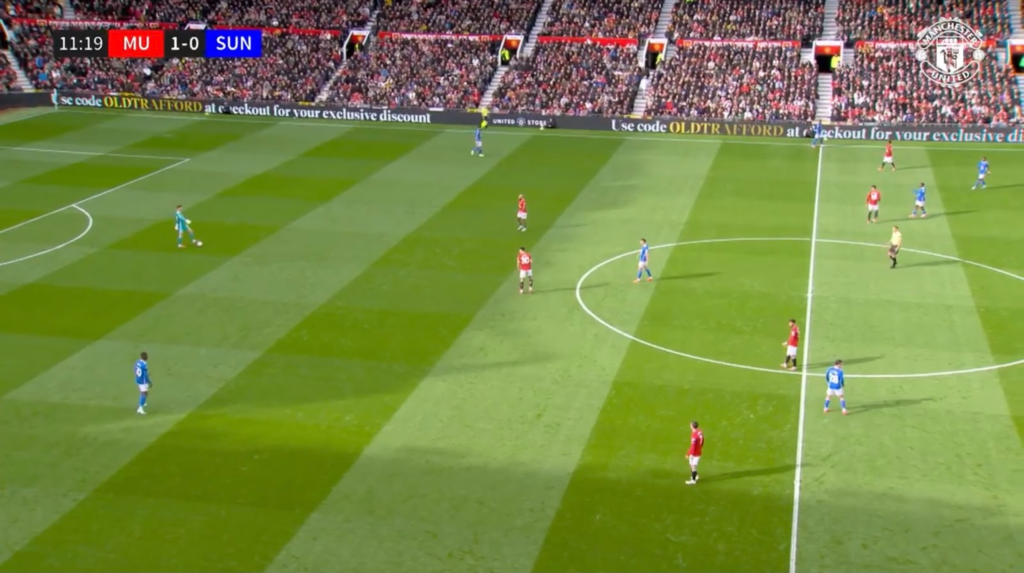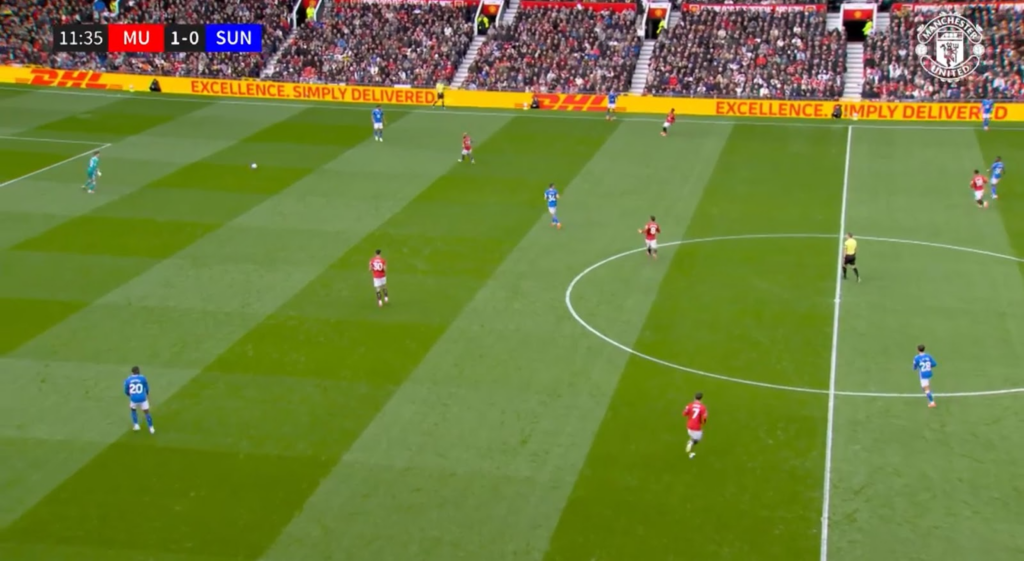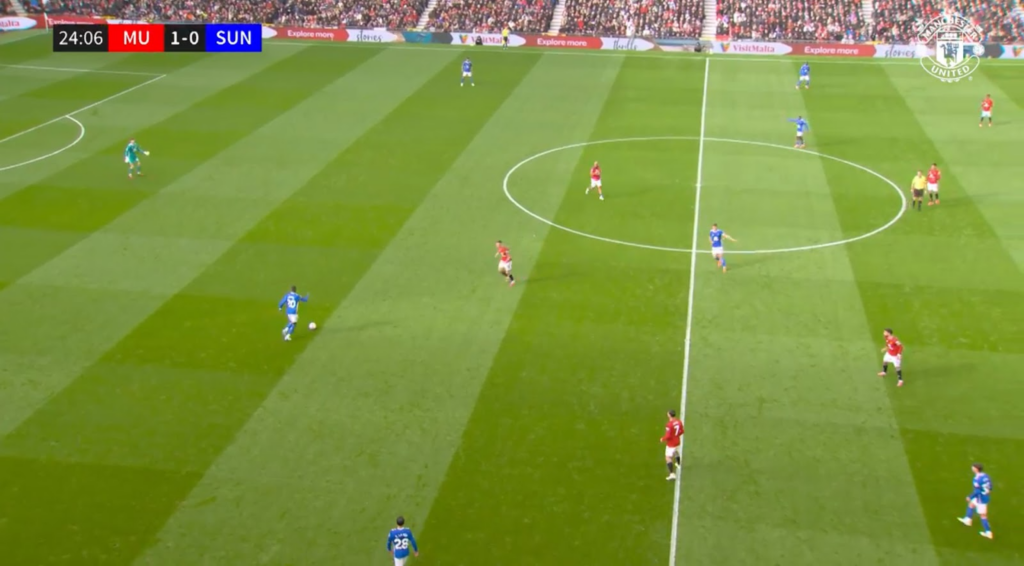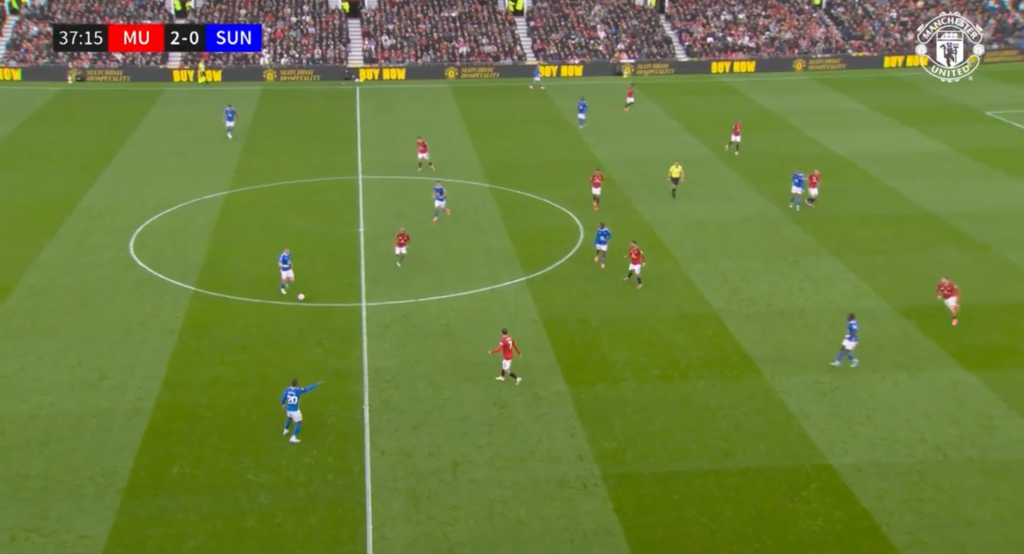Manchester United’s 5-2-3 formation, particularly in out-of-possession situations, has consistently been proven to be deeply ineffective. Against Sunderland, Ruben Amorim finally changed the shape of his team off the ball. But why did he do this, and is this change permanent?
Since arriving at Manchester United, Ruben Amorim has been adamant that he will not move away from the 3-4-2-1 system that brought him so much success in Portugal at Sporting CP.
United, like most teams in modern football, use a 3-2-5 on the ball. The beauty of the 3-4-2-1 is that it makes the transition between attacking and defensive shapes very easy.
That being said, a back five off the ball makes it difficult to apply pressure on the ball, and the 5-2-3 formation in particular leaves a team very vulnerable in midfield.
The lack of presence in midfield is something many teams have exploited when playing against United, but Amorim tweaked the shape against Sunderland.
Amorim switched to 4-4-2 off the ball
Ruben Amorim moved away from his 5-2-3 and adopted a 4-4-2 shape off the ball in United’s fixture on Saturday afternoon against Sunderland. Régis Le Bris set his team up in a 2-3-5/2-3-2-3 shape on the ball.
The switch in United’s formation was purely because of Sunderland’s shape. Amorim always employs a 4-4-2 formation against teams that use a 2-3-5 formation. The reason for this adaptation is that if he used the 5-2-3, it would leave the opposition full-backs, or at least one of them, completely free.
Benjamin Šeško and Bryan Mbeumo led the press, with Amad on the right and Mason Mount on the left. Amad pushing up meant Leny Yoro became the right-back.

When Robin Roefs was on the ball, United didn’t press. Instead, the front two of Šeško and Mbeumo marked Granit Xhaka to ensure Roefs couldn’t play a pass to find him. Bruno Fernandes was responsible for marking Enzo Le Fee, while Casemiro marked Noah Sadiki.

When the ball was played to the centre-backs, though, United would trigger the press. Šeško and Mbeumo would press the centre-backs. This meant Xhaka became free, so Fernandes was responsible for tracking him. Casemiro continued to mark Sadiki, while Le Fee became free. Sunderland, therefore, had a +1 in midfield.
Le Fee is an outstanding technician and an excellent career, so allowing him to roam free was a bizarre decision by Ruben Amorim.

Amorim did recognise his mistake eventually. He tweaked the press to keep the front two more narrow. Depending on which side of the pitch the ball was on, the tweak allowed either Šeško or Mbeumo to shadow mark Xhaka.
This, therefore, meant Fernandes could track Le Fee. Of course, though, if Sunderland did somehow find Xhaka, they would still have a +1 in midfield.
Amorim reverted back to the 5-2-3 following Sunderland change
It’s not often you see managers make tactical changes in the first half of games, but that is precisely what Régis Le Bris did at Old Trafford.
With his team trailing 2-0, Le Bris took off winger Simon Adringa and replaced him with centre-back Daniel Ballard. Sunderland therefore switched to a back three. Instead of the 2-3-5 on the ball, they at this point switched to a 3-2-5.

As soon as this happened, United reverted to the 5-2-3. This proved that the switch to the 4-4-2 wasn’t a long-term change Amorim wanted to implement, but rather a change made due to the set-up of the opposition.
Why the 5-2-3 is ineffective
A 3-2-5 against a 5-2-3 means the game becomes man-to-man. When pressing high up the pitch, going man-to-man is ideal because it means the opponent doesn’t have numerical superiority anywhere on the pitch.
Everyone does have to be fully switched on to track their man and follow positional rotations, but when coached well, it’s very effective.
READ MORE: Senne Lammens forces ex-Manchester United star into embarrassing U-turn as ‘brilliant’ point made
However, in a mid-block, you need to settle into a more compact shape. As mentioned above and talked about by Fulham Boss Marco Silva, it’s very easy to overload the 5-2-3 in midfield, especially if the centre-backs don’t follow the 10s when they drop deep.
Amorim has shown he has the solutions. The 4-4-2 formation works well, and at times, he has used a 5-4-1 formation. Both of those shapes are far more solid in the mid-block. Moving to a 5-4-1 is a relatively minor adjustment, but it would significantly improve coverage in midfield. It worked brilliantly against Liverpool at Anfield last season.
Amorim might like to keep the two 10s higher up in the mid-block to try and apply more pressure on the ball, but it’s not worth the risk of leaving your midfield very empty.
The solutions are clear. Amorim must use them at some point if he is to have any kind of long-term success and save his career at Old Trafford.
Make sure to follow UtdDistrict on X, Instagram, Facebook, YouTube, and TikTok to never miss out on any of our Manchester United content. Our podcast, What the Devil?, is streamed live every Thursday at 12:30 pm (BST) on the United View YouTube channel.